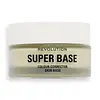What's inside
What's inside
 Key Ingredients
Key Ingredients

 Benefits
Benefits

 Concerns
Concerns

 Ingredients Side-by-side
Ingredients Side-by-side

Water
Skin ConditioningCyclopentasiloxane
EmollientPhenyl Trimethicone
Skin ConditioningIsohexadecane
EmollientPentaerythrityl Tetraisostearate
EmollientEthylhexyl Stearate
EmollientGlycerin
HumectantCetyl PEG/PPG-10/1 Dimethicone
EmulsifyingEthylhexyl Palmitate
EmollientSodium Chloride
MaskingSorbitan Sesquioleate
EmulsifyingTrimethylsiloxysilicate
EmollientDimethicone
EmollientQuaternium-90 Bentonite
Hydrogenated Castor Oil
EmollientPhenoxyethanol
PreservativePropylene Carbonate
SolventDimethicone Crosspolymer
Emulsion StabilisingMica
Cosmetic ColorantCaprylyl Glycol
EmollientCannabis Sativa Seed Oil
EmollientTocopheryl Acetate
AntioxidantButylene Glycol
HumectantPolyhydroxystearic Acid
EmulsifyingLecithin
EmollientSalicylic Acid
MaskingNiacinamide
SmoothingSilica Dimethyl Silylate
EmollientPolyester-1
Isopropyl Myristate
EmollientIsostearic Acid
CleansingPolyglyceryl-3 Polyricinoleate
EmulsifyingPentaerythrityl Tetra-Di-T-Butyl Hydroxyhydrocinnamate
AntioxidantCentella Asiatica Extract
CleansingChlorophyllin-Copper Complex
AntioxidantPolygonum Cuspidatum Root Extract
AntioxidantScutellaria Baicalensis Root Extract
AstringentSodium Hydroxide
BufferingCamellia Sinensis Leaf Extract
AntimicrobialGlycyrrhiza Glabra Root Extract
BleachingChamomilla Recutita Flower Extract
MaskingRosmarinus Officinalis Leaf Extract
AntimicrobialDextrin
AbsorbentCI 77891
Cosmetic ColorantCI 77288
Cosmetic ColorantCI 77492
Cosmetic ColorantCI 77499
Cosmetic ColorantCI 77491
Cosmetic ColorantWater, Cyclopentasiloxane, Phenyl Trimethicone, Isohexadecane, Pentaerythrityl Tetraisostearate, Ethylhexyl Stearate, Glycerin, Cetyl PEG/PPG-10/1 Dimethicone, Ethylhexyl Palmitate, Sodium Chloride, Sorbitan Sesquioleate, Trimethylsiloxysilicate, Dimethicone, Quaternium-90 Bentonite, Hydrogenated Castor Oil, Phenoxyethanol, Propylene Carbonate, Dimethicone Crosspolymer, Mica, Caprylyl Glycol, Cannabis Sativa Seed Oil, Tocopheryl Acetate, Butylene Glycol, Polyhydroxystearic Acid, Lecithin, Salicylic Acid, Niacinamide, Silica Dimethyl Silylate, Polyester-1, Isopropyl Myristate, Isostearic Acid, Polyglyceryl-3 Polyricinoleate, Pentaerythrityl Tetra-Di-T-Butyl Hydroxyhydrocinnamate, Centella Asiatica Extract, Chlorophyllin-Copper Complex, Polygonum Cuspidatum Root Extract, Scutellaria Baicalensis Root Extract, Sodium Hydroxide, Camellia Sinensis Leaf Extract, Glycyrrhiza Glabra Root Extract, Chamomilla Recutita Flower Extract, Rosmarinus Officinalis Leaf Extract, Dextrin, CI 77891, CI 77288, CI 77492, CI 77499, CI 77491
 Reviews
Reviews

Alternatives
Ingredients Explained
These ingredients are found in both products.
Ingredients higher up in an ingredient list are typically present in a larger amount.
Dimethicone is a type of synthetic silicone created from natural materials such as quartz.
What it does:
Dimethicone comes in different viscosities:
Depending on the viscosity, dimethicone has different properties.
Ingredients lists don't always show which type is used, so we recommend reaching out to the brand if you have questions about the viscosity.
This ingredient is unlikely to cause irritation because it does not get absorbed into skin. However, people with silicone allergies should be careful about using this ingredient.
Note: Dimethicone may contribute to pilling. This is because it is not oil or water soluble, so pilling may occur when layered with products. When mixed with heavy oils in a formula, the outcome is also quite greasy.
Learn more about DimethiconeGlycerin is already naturally found in your skin. It helps moisturize and protect your skin.
A study from 2016 found glycerin to be more effective as a humectant than AHAs and hyaluronic acid.
As a humectant, it helps the skin stay hydrated by pulling moisture to your skin. The low molecular weight of glycerin allows it to pull moisture into the deeper layers of your skin.
Hydrated skin improves your skin barrier; Your skin barrier helps protect against irritants and bacteria.
Glycerin has also been found to have antimicrobial and antiviral properties. Due to these properties, glycerin is often used in wound and burn treatments.
In cosmetics, glycerin is usually derived from plants such as soybean or palm. However, it can also be sourced from animals, such as tallow or animal fat.
This ingredient is organic, colorless, odorless, and non-toxic.
Glycerin is the name for this ingredient in American English. British English uses Glycerol/Glycerine.
Learn more about GlycerinSodium Hydroxide is also known as lye or caustic soda. It is used to adjust the pH of products; many ingredients require a specific pH to be effective.
In small amounts, sodium hydroxide is considered safe to use. However, large amounts may cause chemical burns due to its high alkaline.
Your skin has a natural pH and acid mantle. This acid mantle helps prevent harmful bacteria from breaking through. The acid mantle also helps keep your skin hydrated.
"Alkaline" refers to a high pH level. A low pH level would be considered acidic.
Learn more about Sodium HydroxideWater. It's the most common cosmetic ingredient of all. You'll usually see it at the top of ingredient lists, meaning that it makes up the largest part of the product.
So why is it so popular? Water most often acts as a solvent - this means that it helps dissolve other ingredients into the formulation.
You'll also recognize water as that liquid we all need to stay alive. If you see this, drink a glass of water. Stay hydrated!
Learn more about Water